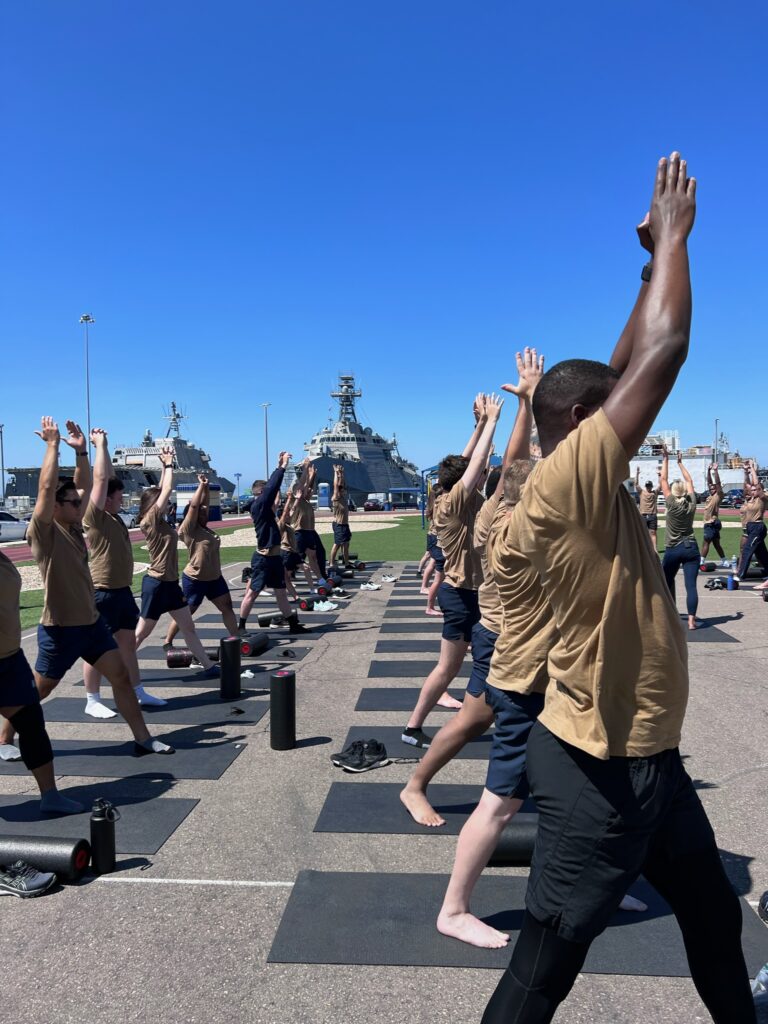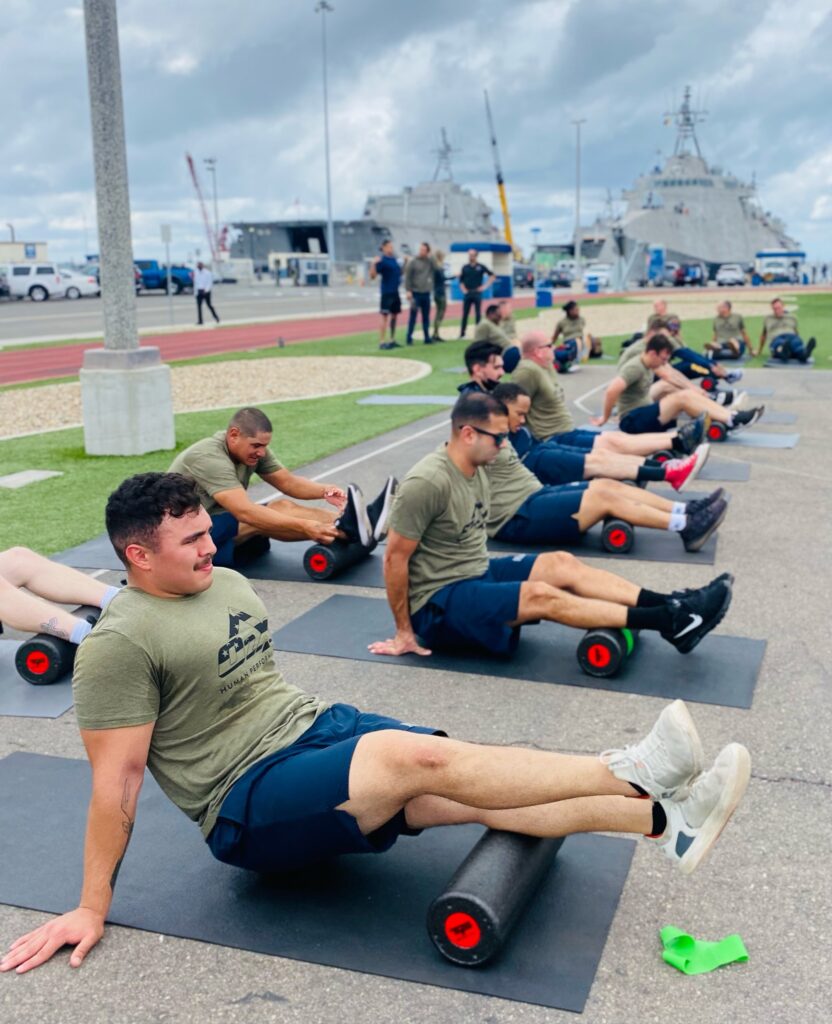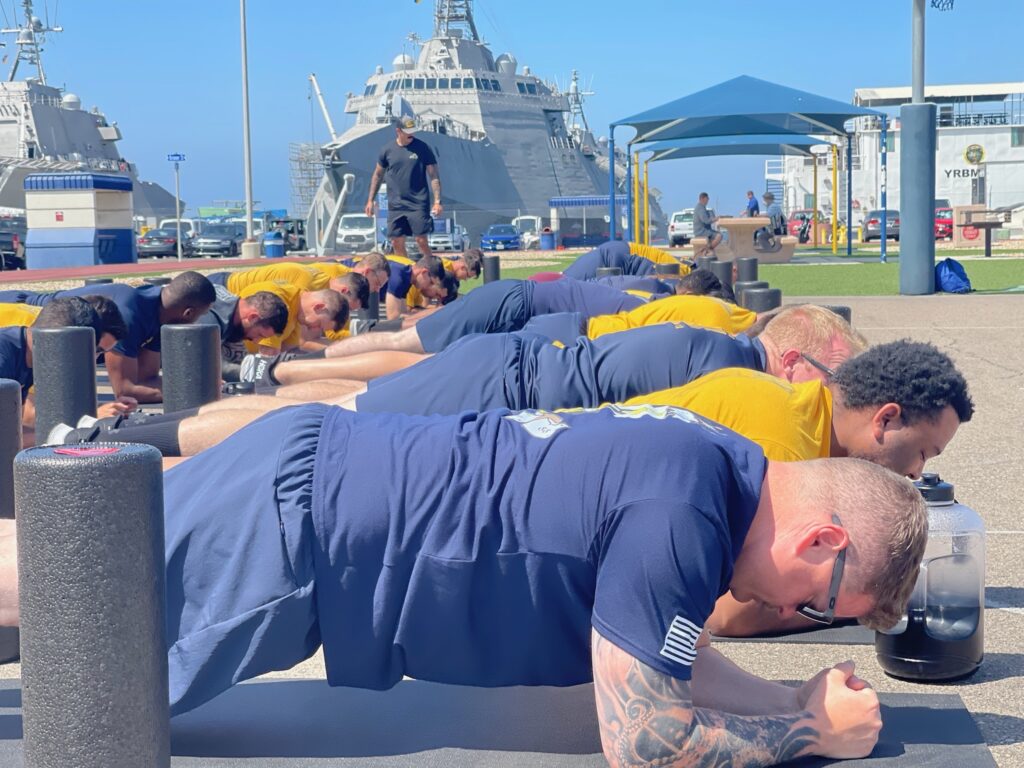
On the surface of it, the idea of training Sailors about nutrition, exercise, fitness, injury prevention, sleep and mental well-being didn’t seem like a hard sell. Two days of classroom instruction, workout drills and yoga sessions, all led by professional trainers, gave them a temporary break in their routine aboard ship in homeport at Naval Base San Diego.
The workshops led by O2X Human Performance over the past year are an outgrowth of an innovative program that began in 2021 at Surface Warfare Officers School to teach future ship commanders how to better lead their crews by maximizing their own work performance, physical fitness, mental health and mental readiness. The holistic approach to these programs are among the surface Navy’s continuing course changes after investigations into the causes of shipboard mishaps, including collisions and groundings, found commanders and crews plagued by sleep deprivation, stress, fatigue and inadequate training.
The initial series of workshops for ships’ crews — supported by Naval Surface Force officials in concert with Naval Health Research Center’s Crew Readiness and Watchstanding (CREW) efforts — found that all Sailors benefit from the training and incorporated it into their own work and personal lives.
“We’ve collected a substantial data. It’s loved. Everybody likes it,” said Dale Russell, the Naval Surface Force’s operational safety and human factors advisor in San Diego.
As of mid-October, 770 Navy personnel have gone through the O2X program since it was incorporated into the Prospective Commanding Officer/Executive Officer courses at Surface Warfare Officer School in Newport, Rhode Island, according to O2X Human Performance, a Scituate, Massachusetts-based company founded by three former Navy SEALs. That includes 440 officers at SWOS and 305 sailors and officers from Naval Surface Forces Pacific ships in San Diego, including destroyer USS Preble (DDG 88), littoral combat ship USS Manchester (LCS 14) and, more recently, the Blue Crew of USS Omaha (LCS 12).
Buoyed by the positive feedback, Naval Surface Force is weighing the next step and plans to expand its investment across the waterfront by developing a program in-house. Consider it the human equivalent of preventative maintenance measures the Navy long has had in place for its multi-billion-dollar inventories of ships and aircraft.
Preventative Maintenance
It would be “an O2X-like program that is organic to the fleet and is built around firefighting and damage control,” Russell said. “It will give the team something to rally around. It’ll build unit cohesion, solidarity, camaraderie… [and] it’ll give them a context to get into physical shape. This will give them something to train around.”
An ongoing CREW study, into wearables for fatigue management, is helping get “this curriculum in front of as many Sailors, leaders and surface fleet that we possibly can,” said Adam La Reau, a former SEAL and co-founder of O2X Human Performance. Sailors “are excited that the Navy is putting the time into them.
“We’re providing skills-based training. That education, just like with their skills-based training with the jobs that they do every single day, continues,” La Reau said. “Human performance is no different than [training] in their roles as a navigator. They constantly have to learn.”
“This is not something that you provide one time,” he said. Ideally, “they have to be built into their routine, built into their battle rhythms, but also at touchpoints. These are hard installs of education along the way. It could be when a ship is coming out of a maintenance cycle. It could be at Great Lakes, post-A School. It could be periodically when a ship crew change-out happens.”

O2X’s mantra focuses on one making small but important incremental changes of 1% — whether in sleep or nutrition habits, managing stress or exercise routine. Each workshop wraps up with an all-hands discussion on making that goal a daily reality. “It’s not just with the leaders, it’s with the entire crew and teaching them about taking ownership,” La Reau said.
“It’s like everyone’s on a team, and you’re walking into a locker room every single day and we continue to fill each other up. We find ways as an organization, not necessarily waiting for the CO or the XO or one of the senior enlisted to step up and say something. Everybody has a voice here,” he added. “The Sailors have a ton of examples of previous ships and past experiences that may be small things that we could potentially change. We don’t have to do it the way we’ve always done it.”
O2X Human Performance is working with Naval Health Research Center over the next year in the CREW study and with the Navy’s Center for Security Forces and is talking with aviation and safety commands for potential collaboration in similar vein as the fleet.
“There’s quite a bit of appetite and opportunity,” La Reau said, noting the training touches on safety, health, wellness, readiness, resilience, retention and maybe recruitment. “There’s also a risk-mitigation factor here. It’s driving self awareness. It’s understanding what your capabilities are, understanding … how to persevere through challenging times or in the moment to be able to dig into resources to execute at a very high level.”
The best part, he said, is “we’re seeing these individuals saying, ‘I need to make a change. Me being a good leader is definitely tied to taking care of myself and me being a good example. Especially onboard a vessel, onboard a ship. People are emulating what I do and how I live my life. I need to take care of myself, so I can take care of my ship and my Sailors and so I can be the best leader that I can be. And I can do the things that the country has asked me to do.’”
Naval Surface Force and Naval Health Research Center continue to process and analyze feedback and data collected through the workshops’ participants who use wearable devices that track sleep, exercise and other information. “The scientific literature is pretty clear: If you exercise, your biophysical response makes you sleep better, which gives cortisol, which makes you feel better. It builds social bonds, which make you feel better, sleep better, exercise better,” Russell said. “So, it’s a positive feedback loop.”
The reality of daily life in the fleet, however, makes physical training extremely hard for many Sailors and crews to sustain, he acknowledged. But Sailors want just that. In safety climate assessments across the fleet, collected as part of the CREW effort over the last two years, “Sailors have voiced: We really want to work out more. We’re bummed that we don’t have group PT,” Russell said. “A very small percentage of the ships even have mandatory PT, because of the nature of the environment they work in. We’ve realized that a paradigm shift is needed, but that’s easier said than done in a large organization like ours.”
Naval Surface Force officials, led by Vice Adm. Roy Kitchener, are working to change that. As it develops its organic human performance training, the surface Navy also will roll out a new watchbill software, OWL, designed to help leaders and crews manage fatigue.
“We are right now pilot-testing that on, I think eight ships this fall, currently. If this works out, then we’ll start rolling it out to the fleet next year, fleetwide,” Russell said. “We are getting ready to rewrite our CREW Endurance instruction to capture that.”

Wearable Devices
SURFOR also is looking at using wearable devices as “an occupational management” tool, he said, provided they can develop algorithms that work for shipboard life. Trackers such as Fitbit work if one is “walking on terra firma, not on water, which throws off some of the sensors on it,” he said. With 18 months of data collected so far, SURFOR is “putting motion sensors aboard the ships so we can kind of get a feel for how a ship like an LCS bobs in the water as opposed to an amphib, so we can tweak the algorithm based on whatever ship they’re on.
“The plan will be to roll out 55,000 wearables to the entire fleet,” he said, acknowledging the challenge since one-third of a ship’s crew turns over annually. More likely those devices would be fielded to field it to “key, critical billets,” likely the bridge, engineering and combat information center.
Several months ago, Kitchener allocated $1 million for the authority to operate “a wireless hub to go on ships and pull the data off the wearables to the ship’s network — CANES — and feed it into OWL,” Russell said. If all goes as planned, that connectivity will be up and running on those ships during exercise Talisman Saber in 2023 “so we can kind of pressure-test it.”
“OWL will give the leadership on the ship that visibility of what’s going on. … They can break it down by department, watchbill, however they want to slice and dice that data,” he said. Connectivity can be spotty at sea, so they’re looking to push data off the ship and into Jupiter, the Navy’s enterprise data link environment. The combination of OWL implementation and wearables could provided a “check engine,” light, for example, for someone who didn’t sleep well at night.
“That could the touchpoint” for a leader to then ask them to go see medical or ask about their sleep, Russell said. “So no matter – whether you have COVID or whether you haven’t slept well or you had a fight with your loved one or you’ve got an STD — it’s your heart-rate variability and deviation from that. … We’re just trying to trigger that touchpoint and say, something’s wrong. Let’s go see what might be wrong.”
- Ships and Human Performance: Surface Forces Take Holistic Approach to Sailors, Crew Training - December 20, 2022
- From Submarine to Mars Explorer, Discovery is this Navy Veteran’s Mission - September 16, 2021
- Fatigue at Sea: Researching How Lack of Sleep Can Affect Sailors - February 25, 2021




